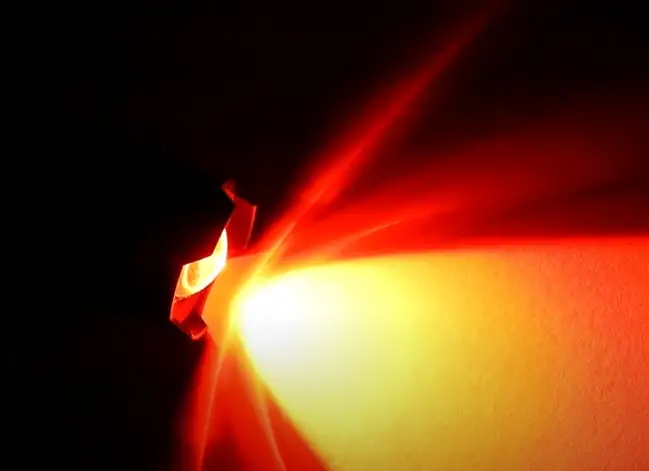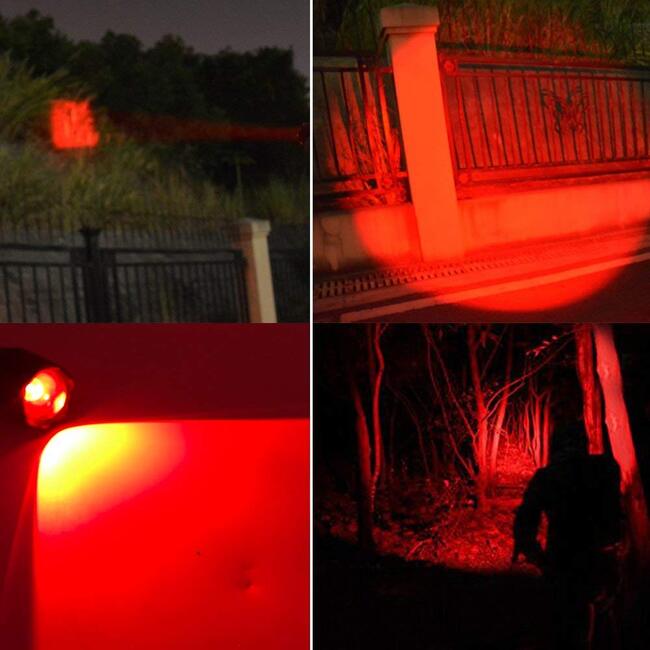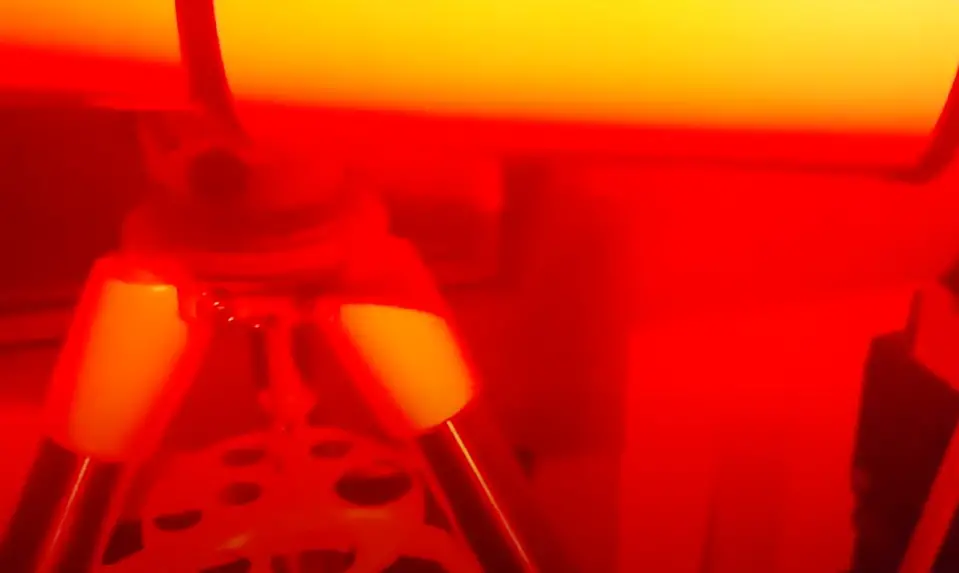If you’re a stargazer or an astronomer, you know how important it is to have the right equipment to make your observations. One of the most essential tools you’ll need is a good flashlight. However, did you know that not all flashlights are created equal? In fact, a red flashlight can be incredibly beneficial for your astronomy needs.
Red flashlights are often used by astronomers and stargazers because they don’t affect your night vision as much as white light. This is because the human eye is less sensitive to red light, so it won’t cause your pupils to contract and your eyes to adjust to the dark again.
This means you can use your red flashlight to read star charts, adjust your telescope, or navigate your way through the dark without ruining your night vision. Read more about night vision here.
Additionally, red flashlights are great for preserving the natural beauty of the night sky. White light can be distracting and can wash out the stars, making it harder to see the celestial objects you’re trying to observe. Red light, on the other hand, is much less intrusive and won’t interfere with your view of the stars. So if you’re serious about your astronomy, investing in a good red flashlight is definitely worth considering.
How to Use a Red Flashlight
Turning On and Adjusting the Brightness
Using a red flashlight is a great way to preserve your night vision during observing sessions. To turn on your red flashlight, locate the power button, usually located on the side or bottom of the flashlight. Press and hold the button until the light comes on.
Most red flashlights have multiple brightness settings. To adjust the brightness, locate the brightness button, usually located near the power button. Press the button to cycle through the different brightness levels until you find the level that is comfortable for you.
Proper Use During Observing Sessions
When using a red flashlight during observing sessions, it’s important to use it properly to avoid disrupting your night vision or the night vision of others. Here are a few tips:
- Point the flashlight away from other observers to avoid shining the light in their eyes.
- Use the lowest brightness setting possible to avoid disrupting your night vision.
- Turn off the flashlight when not in use to avoid accidentally shining it in someone’s eyes.
By following these tips, you can use your red flashlight effectively and safely during observing sessions.
When to Use a Red Flashlight
If you’re interested in stargazing or astronomy, you probably know that your eyes need time to adjust to the darkness. Any bright light can ruin your night vision, making it difficult to see the stars. This is where a red flashlight comes in handy. Here are some situations where you might want to use a red flashlight:
Stargazing and Astronomy Clubs
When you’re out with a group of stargazers, it’s important to be considerate of others. A bright flashlight can ruin everyone’s night vision, so a red flashlight is a great option. It will allow you to see your way around without disturbing others.
Astrophotography Sessions
If you’re taking pictures of the night sky, you’ll want to use a red flashlight to avoid ruining your night vision. A bright flashlight could cause you to miss out on some great shots, so it’s important to use a red flashlight instead.
Home Observations
If you’re observing the night sky from your backyard, a red flashlight isn’t needed, but it is a great tool to have. It will allow you to see your way around without disturbing your neighbors or ruining your night vision. Plus, it’s a great way to introduce kids to the wonders of the night sky without disrupting their sleep patterns.
Benefits and Limitations of Red Flashlights

Advantages of Red Light for Night Vision
If you need to maintain your night vision while using a flashlight, a red light can be a great option. Unlike white light, which can instantly degrade your night vision, red light doesn’t cause your pupils to contract and allows you to see in low light conditions without losing your ability to see in the dark. This makes it an ideal choice for other activities too; like camping, hiking, and hunting.
Red light can also be less disruptive to wildlife and other people around you. Because red light disperses or gets absorbed before white light, it will minimize the impact on others.
Potential Drawbacks
While red flashlights have many benefits, they also have some potential drawbacks to consider. One of the main limitations of red light is that it doesn’t provide as much visibility as white light. This can make it difficult to see details or navigate in unfamiliar terrain. Additionally, red light can make it more difficult to read maps or other printed materials in low light conditions.
Another potential limitation of red light is that it can be difficult to find in stores. While many outdoor retailers carry red flashlights, they may not be as widely available as white light flashlights. This can make it challenging to find the right red light for your needs.
Do You Need a Red Flashlight for Astronomy?
If you’re an astronomy enthusiast, you may have heard about using a red flashlight for stargazing. But do you really need one? Let’s explore the benefits of using a red flashlight for different types of astronomers.
Beginner Astronomers
If you’re new to astronomy, you may not be familiar with the importance of preserving your night vision. Using a bright white flashlight can ruin your eyes’ ability to see in the dark, making it harder to observe faint objects in the night sky. A red flashlight, on the other hand, emits light that won’t affect your night vision as much. This makes it easier to navigate your equipment and find your way around the sky without losing your ability to see faint objects. Learn more about night vision here.
Experienced Observers
If you’re an experienced observer, you may already be using a red flashlight. However, you may want to consider upgrading to a more powerful red flashlight for better visibility. A brighter red flashlight can make it easier to read star charts, adjust your equipment, and find your way around the sky. Look for a red flashlight with adjustable brightness levels so you can customize it to your needs.
Casual Stargazers
If you’re a casual stargazer who enjoys looking up at the sky from time to time, you may not need a red flashlight. However, if you do decide to invest in one, it can enhance your stargazing experience by allowing you to see more detail in the night sky. A red flashlight can also be a fun and useful tool for camping trips or other outdoor activities.
Types and Variations of Red Flashlights
When it comes to red flashlights, there are several types and variations available. Here are some of the most common:
Dedicated Red Astronomy Flashlights
If you’re an astronomy enthusiast, a dedicated red astronomy flashlight might be the perfect choice for you. These flashlights are designed specifically for stargazing and other low-light activities. They typically have a very dim red light that won’t interfere with your vision or disrupt your night vision. Some popular models include the Celestron 93588 Night Vision Flashlight and the Orion 5768 RedBeam Mini LED Flashlight
.
Multi-color Flashlights
Multi-color flashlights are another popular option. These flashlights allow you to switch between different colored lights, including red, white, blue, and green. This can be useful in a variety of situations, from camping and hiking to emergency preparedness. Some popular models include the DaskFire 4 Colored Tactical Flashlight and the Nitecore SRT7GT 1000 Lumen Flashlight.
DIY Solutions
If you’re on a budget or just enjoy DIY projects, you might consider making your own red flashlight. This can be done by simply placing a red filter over the lens of a regular flashlight. You can purchase red filters online or at your local camping or outdoor store. Alternatively, you can use red cellophane or even red nail polish to create your own filter.
Overall, there are many different types and variations of red flashlights to choose from. Whether you’re an astronomy enthusiast, a camper, or just looking for a reliable emergency flashlight, there’s sure to be a red flashlight that meets your needs.
Average Cost of Red Flashlights
If you’re in the market for a red flashlight, you may be wondering how much you should expect to pay. The price of a red flashlight can vary depending on a number of factors. In this section, we’ll take a look at the average cost of red flashlights, as well as the factors that can affect their price.
Price Range
The price of a red flashlight can range from as low as $5 to as high as $100 or more. The exact price you’ll pay will depend on several factors, including the brand, quality, and features of the flashlight.
At the lower end of the price range, you can find basic red flashlights that are simple and straightforward. These may be suitable for occasional use or for those on a tight budget. However, they may not be as durable or reliable as more expensive models.
On the higher end of the price range, you’ll find more advanced red flashlights with a range of features. These may include multiple brightness settings, rechargeable batteries, and durable construction. These flashlights are often designed for professional use and may be more expensive, but they can also provide better performance and reliability.
Factors Affecting Cost
Several factors can affect the cost of a red flashlight. These include:
- Brand: Some brands are known for producing high-quality flashlights and may charge more for their products.
- Quality: Higher quality materials and construction can increase the cost of a flashlight.
- Features: Flashlights with more features, such as multiple brightness settings or rechargeable batteries, may be more expensive.
- Size: Larger flashlights may be more expensive than smaller ones, as they require more materials to produce.
- Intended use: Flashlights designed for professional use may be more expensive than those designed for occasional use.
When choosing a red flashlight, it’s important to consider your needs and budget. While a more expensive flashlight may offer better performance and reliability, it may not be necessary for everyone. Ultimately, the right red flashlight for you will depend on your individual needs and preferences.
Where to Buy Red Flashlights
If you’re in the market for a red flashlight, there are several places you can look. Here are some options:
Online Retailers
One of the easiest ways to find a red flashlight is to search online. There are many retailers that sell flashlights, and some specialize in red lights. Here are a few online retailers to consider:
When shopping online, be sure to read reviews to ensure you’re getting a quality product. Look for flashlights with high ratings and positive feedback from customers.
Local Astronomy Shops
If you’re interested in stargazing, you may want to check out your local astronomy shop. These stores often carry red flashlights for use during nighttime observations.
These stores may also have staff who can provide recommendations based on your needs and budget.
Again, be sure to read reviews and compare prices before making a purchase.
My Picks
Here is my favorite head-lamp for telescope use. It has a separate switch for the red light, and another switch for the white light, say for cleanup, or scary noises even? I like using a head-lamp because sometimes you need 2 hands. I got it here at Astronomy Wear, a smaller site
My favorite red flashlight that I have used is: NAME, and is often available in multiple places. Click here for multiple vendors offering it.
Maintenance and Care for Red Flashlights

Battery Replacement and Management
One of the most important aspects of maintaining your red flashlight is ensuring that the batteries are replaced and managed properly. Always use the type of battery specified by the manufacturer and replace them as soon as they begin to run low. Leaving old or weak batteries in your flashlight can cause damage to the internal components and reduce the overall lifespan of the device.
When storing your flashlight for extended periods of time, remove the batteries to prevent corrosion and leakage. Store the batteries in a cool, dry place and dispose of them properly when they are no longer useful.
Cleaning and Storage
Keeping your red flashlight clean and properly stored is also important for ensuring its longevity. Use a soft, damp cloth to wipe down the exterior of the flashlight and remove any dirt or debris. Avoid using harsh chemicals or abrasive materials that can scratch or damage the surface.
When storing your flashlight, keep it in a cool, dry place and avoid exposing it to extreme temperatures or moisture. Consider using a protective case or pouch to prevent scratches or other damage during transport or storage.
Alternatives and Comparisons
Red Headlamps
If you’re looking for a hands-free option, red headlamps are a great alternative to red flashlights. They’re perfect for camping, hiking, or any outdoor activity where you need to keep your hands free. Most red headlamps have adjustable brightness settings, so you can control the amount of light you need. They’re also lightweight and easy to pack in your backpack. However, they may not be as versatile as a flashlight since they’re designed to be worn on your head, but for astronomy, they free up your hands. (see my pick)
Smartphone Red Light Apps
If you don’t want to carry an extra device, you can use your smartphone as a red light source. There are many apps available that turn your screen into a red light. This is a great option if you’re in a pinch and don’t have a red flashlight or headlamp.
However, keep in mind that using your phone as a light source can drain your battery quickly. Click here for Using your smart phone for a red-light source.
Dimmable White Light Flashlights
If you want a flashlight that can do more than just emit red light, consider a dimmable white light flashlight. These flashlights have adjustable brightness settings, so you can use them as a regular flashlight or switch to red light mode when needed. They’re also more versatile than red flashlights since they can be used in a variety of settings.
However, keep in mind that they may not be as effective as a dedicated red flashlight for preserving night vision. Overall, each alternative has its own benefits and drawbacks. It’s important to consider your specific needs and preferences before choosing the right option for you.
Real-life Examples and Experiences with Red Flashlights
Personal Observations
If you’re an astronomer, you know how important it is to preserve your night vision. Red flashlights are a great tool for this purpose. When you use a red flashlight, you can see what you’re doing without ruining your night vision or disturbing the vision of others around you. To learn more about Night Vision click here.
Another advantage of red flashlights is that they can be used for other activities where you need to see in the dark, such as camping or hiking. With a red flashlight, you can navigate your way around your tent or find your way to the bathroom without disturbing others or ruining your own night vision.
My biggest help here may be to get a flashlight, or headband that has a switch for red light only! Your all set up viewing and you have to click through the settings, your night vision is gone high white, low white, flashing white, then red…now you have to wait about 45 minutes at my age to get acclimated again.
Testimonials from Other Astronomers
“I’ve been using a red flashlight for years, and I can’t imagine observing without one. It’s so much easier to find my way around the telescope and make adjustments without losing my night vision. I also love that I can use it for other activities like camping and hiking.” – John, amateur astronomer
“I was hesitant to try a red flashlight at first, but now I’m a convert. It’s amazing how much easier it is to see things in the dark without ruining your vision. I also appreciate that it’s not as bright or distracting as a regular flashlight.” – Sarah, professional astronomer
“I’ve been using a red flashlight for years, and it’s made a huge difference in my observing experience. I can focus on my work without worrying about disturbing others or ruining my own vision. I highly recommend it to anyone who spends time observing at night.” – Michael, astrophotographer
Conclusion
Using a red flashlight can significantly enhance your night sky experience. The red light does not interfere with your night vision, allowing you to see more stars and celestial objects without having to wait for your eyes to adjust to the darkness again.
Additionally, a red flashlight can be useful for camping or hiking at night, as it does not attract bugs like white light does. This can make your outdoor experience more enjoyable and comfortable.
When choosing a red flashlight, consider factors such as brightness, battery life, and durability. Look for a flashlight with adjustable brightness settings so you can customize the brightness to your needs. A longer battery life will ensure that you can use your flashlight for extended periods of time without having to replace the batteries.
Overall, a red flashlight is a valuable tool for anyone who spends time outdoors at night. Whether you are stargazing, camping, or hiking, a red flashlight can enhance your experience and make your time in the great outdoors more enjoyable.


